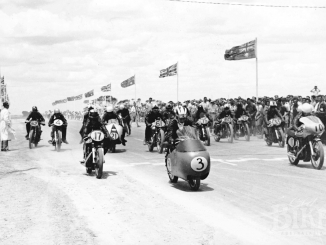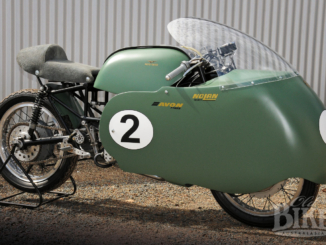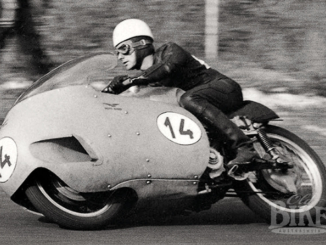
Story and photos Jim Scaysbrook
Moto Guzzi have always been famous for their innovative approach to motorcycle design and engineering. The Galletto (“Cockerel”) was so far ahead of its time that it would still be a practical motorcycle today.
Legend has it that the late Claudio Castiglioni once received a visitor in his office in Varese. The caller represented the Honda Motor Company, and the matter concerned the rear swinging arm that was fitted to the then-new Ducati 916 – the machine that, it was hoped, would turn around the fortunes of the Ducati brand, which was at that stage owned by the Castiglioni family.
Honda’s legal representative carefully explained that the rights to the single-sided swinging arm were covered by a patent owned by Honda, the Japanese giant having paid a considerable sum of money to the French Elf concern, who had in turn developed the concept on the Elf-Honda 500cc Grand Prix bikes ridden quite successfully in the ‘eighties by the likes of Ron Haslam.

Reportedly, Signor Castiglioni listened intently to the visitor’s spiel, which concluded with a demand to cease using their swinging arm design forthwith, or face the full wrath of Honda’s legal eagles. Rising from his chair, Castiglioni walked to a corner of his office where a full length curtain covered the wall. Choosing his words carefully, he said, “You say, the single-sided swinging arm was developed by Elf, and Honda purchased the patent for this design?” The man nodded. “In that case sir,” Castiglioni added with a theatrical pause, “perhaps you can explain the existence of this motorcycle, dating from 1948.” With that, he drew back the curtain, revealing a tiny motorcycle/scooter – the Moto Guzzi Galletto – which incorporated just such an item, not at all dissimilar to the Elf product. That, apparently, was the end of the meeting, and the end of the Honda threat.
It should not have come as a surprise to anyone, including Honda, that such an innovation should have come from the fertile mind of Carlo Guzzi, whose company had been at the cutting edge of technical development from its very instigation in 1920. But there was much more to the little machine, named in Moto Guzzi fashion after a member of the bird family, in this case Galletto, meaning cockerel. It was a brilliant attempt to harness the strengths of both the motorcycle and the scooter into one machine, eliminating the shortcomings and failings of each design.

Traditionally, one of the scooter’s greatest foibles was the use of small wheels, which produced an uncertain ride over the poorly-surfaced streets and roads of the day, and had little in the way of gyroscopic effect, and hence stability. The Galletto pioneered the use of 17-inch wheels, which are today almost universal, and was probably the first solo motorcycle to carry a complete spare wheel and tyre, which sat crossways under the steering head, in front of the leg shield. Front and rear wheels were interchangeable and easily removed.
Of course, technical matters aside, the scooter’s appeal to the masses was based on the protection from the elements that it afforded rider and passenger, and the fact that both could avoid wearing full motorcycle clobber. This was especially appealing to the fairer sex, many of whom found the idea of dressing up in bulky and masculine-oriented protective clothing rather distasteful. In the case of the Galletto, a substantial sheet metal structure enclosed the petrol and oil tanks, with tool boxes set into the rear section. Full leg shields kept rider and pillion out of the elements, and the front mudguard was also deeply valanced to contain spray kicked up by the front wheel. Long foot boards extended along both sides and also acted as pillion footrests.
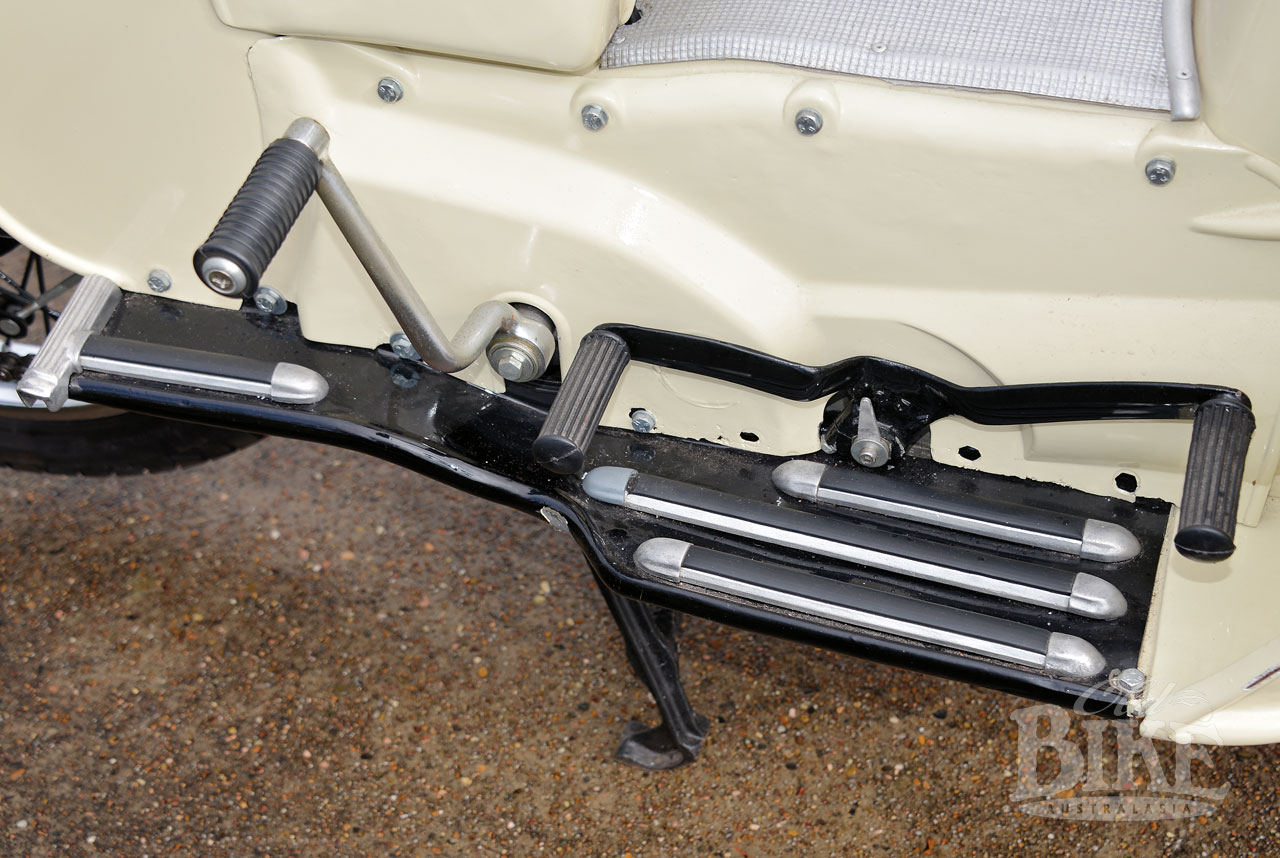
After being on the drawing board and under development since 1948, the Galletto made its public bow at the 1950 Geneva Motor Show, where it appeared in 150cc form with an all-alloy four-stroke ohv engine with the cylinder parallel to the ground in traditional Moto Guzzi fashion, and mated to a three-speed gearbox. By the time it went on sale, the engine had been enlarged slightly to 160cc, with a bore and stroke of 62mm x 53mm and compression ratio of 5.6:1. This gave a power output of 6 horsepower at 5,200 rpm. A Marelli flywheel magneto with a contact breaker mounted on the end of the crankshaft supplied the spark, with a spark plug located in the side of the head. The flywheel magneto also generated current for lighting (which included a dipping headlight, a rarity for the era) that passed through a rectifier to the battery. The engine breathed through a Dell’Orto MA 18 carburettor which had an air filter enclosed in a pressed metal cap that protruded through the left side of the bodywork. Clearly a sibling of its racing parents, the little engine featured an alloy head with integral rocker boxes and totally enclosed valves with coil springs.
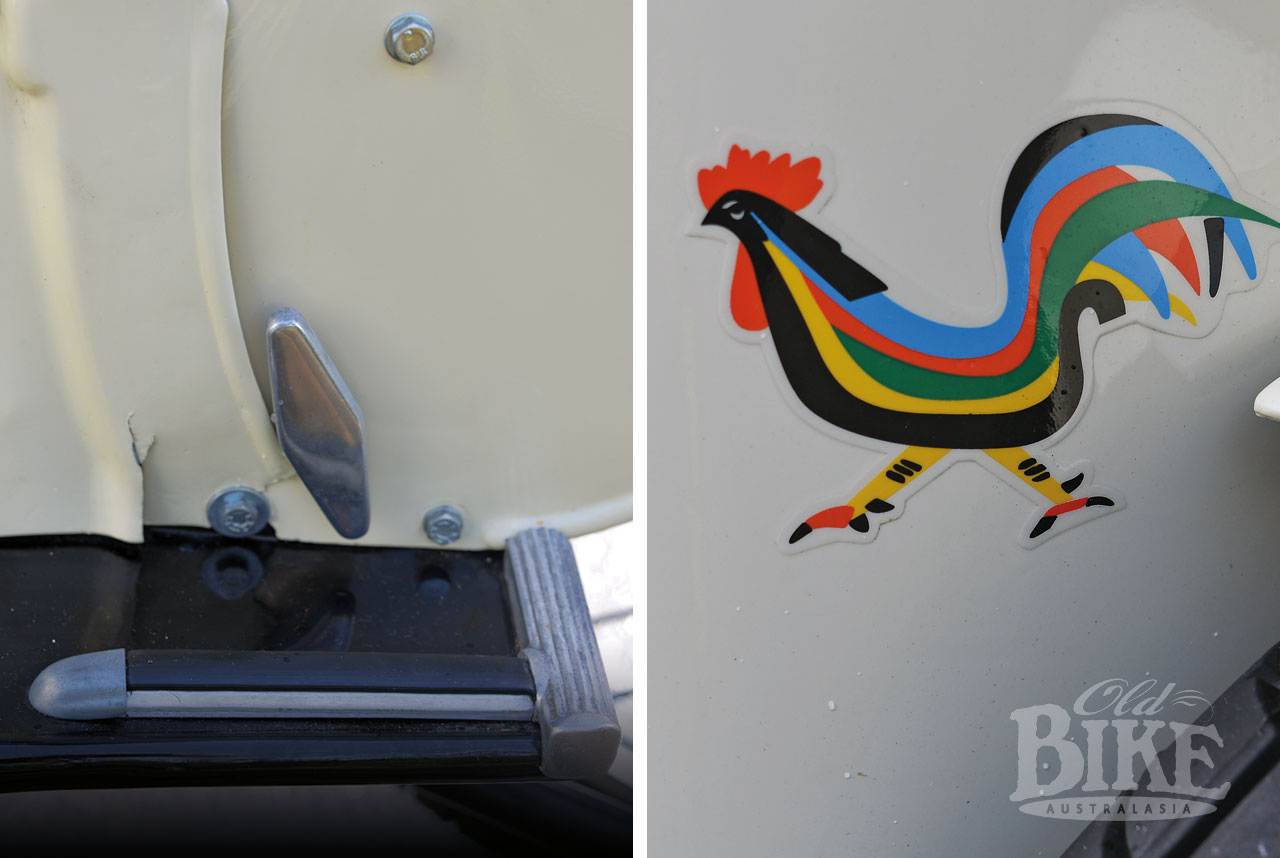
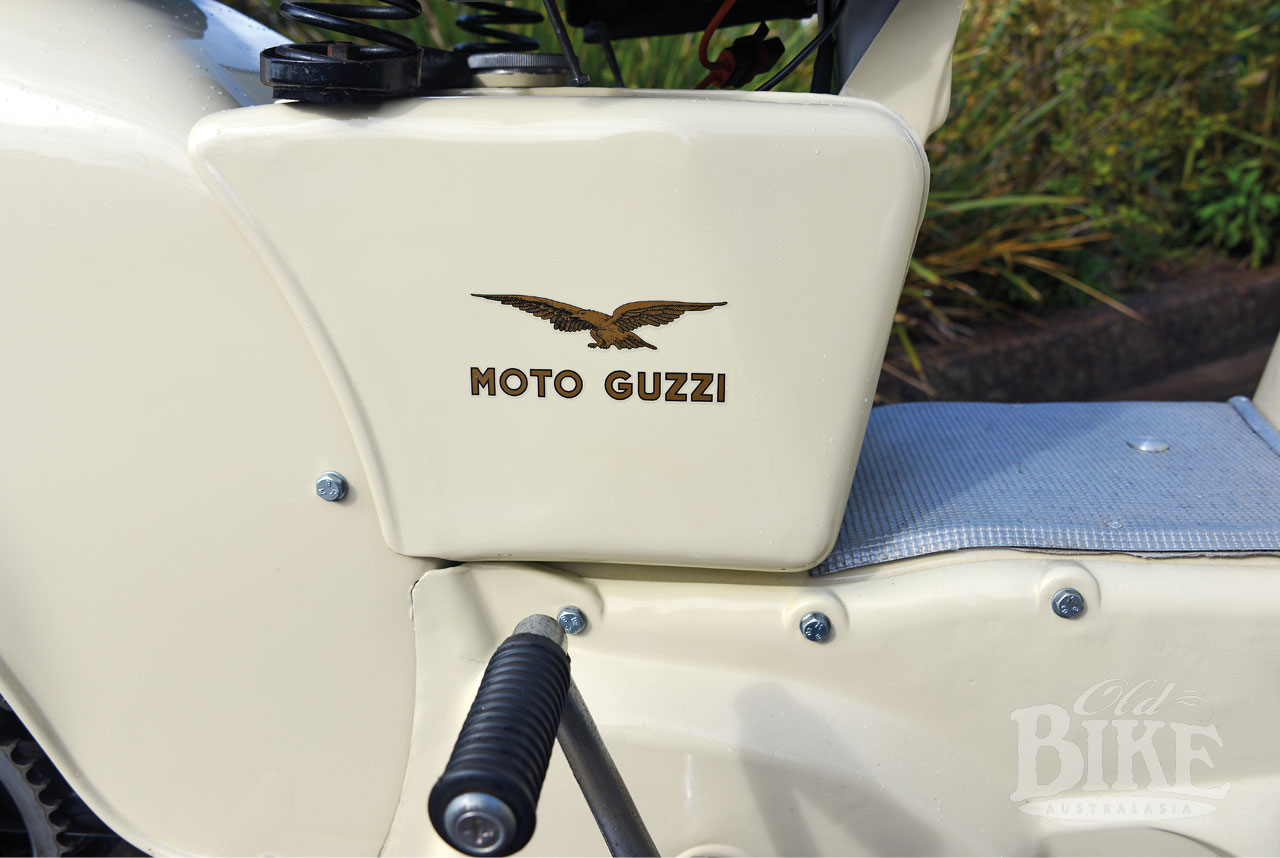
The composite frame was made up of welded steel sheet pressings, angle steel sections and steel castings, with leading link forks at the front that were similar in design to the Guzzi race bikes. At the rear sat the aforementioned single-sided swinging arm, with coil springs under the engine controlled by friction dampers. On the left side below the seat, a diamond-shaped lever allowed the spring loading to be increased when carrying a passenger. The sprocket was mounted on the outside of the swinging arm, on the right hand side, while the wheel was attached by a stub axle feeding from the left. That meant the rear wheel could be quickly removed without disturbing the final drive chain – a point not lost on the Elf Endurance Racers nearly 30 years later. An ingenious touch was the method of rear chain adjustment, via an eccentric stub-axle mounting and a finger lever. The Galletto was announced for sale in Australia in March 1951, with a price tag of £199/10/-, which was pretty hefty considering a new 350cc Matchless could be had for just twelve pounds more. The engine quickly gained extra capacity, first to 175cc and finally to 192cc, with a fourth ratio added to the gearbox. In this form, the Galletto continued in production from 1954 to 1966.
In 1961, an electric starter was included, a feature found on very few motorcycles, regardless of price. This final version also sported revised rear suspension, dispensing with the underslung spring unit in favour of a spring/damper strut mounted well behind the rear axle and looking rather like an afterthought. Front end styling was also revised, with the spare wheel partially covered by a shroud that enclosed the previously exposed steering head. A dual seat was also standard fitment.
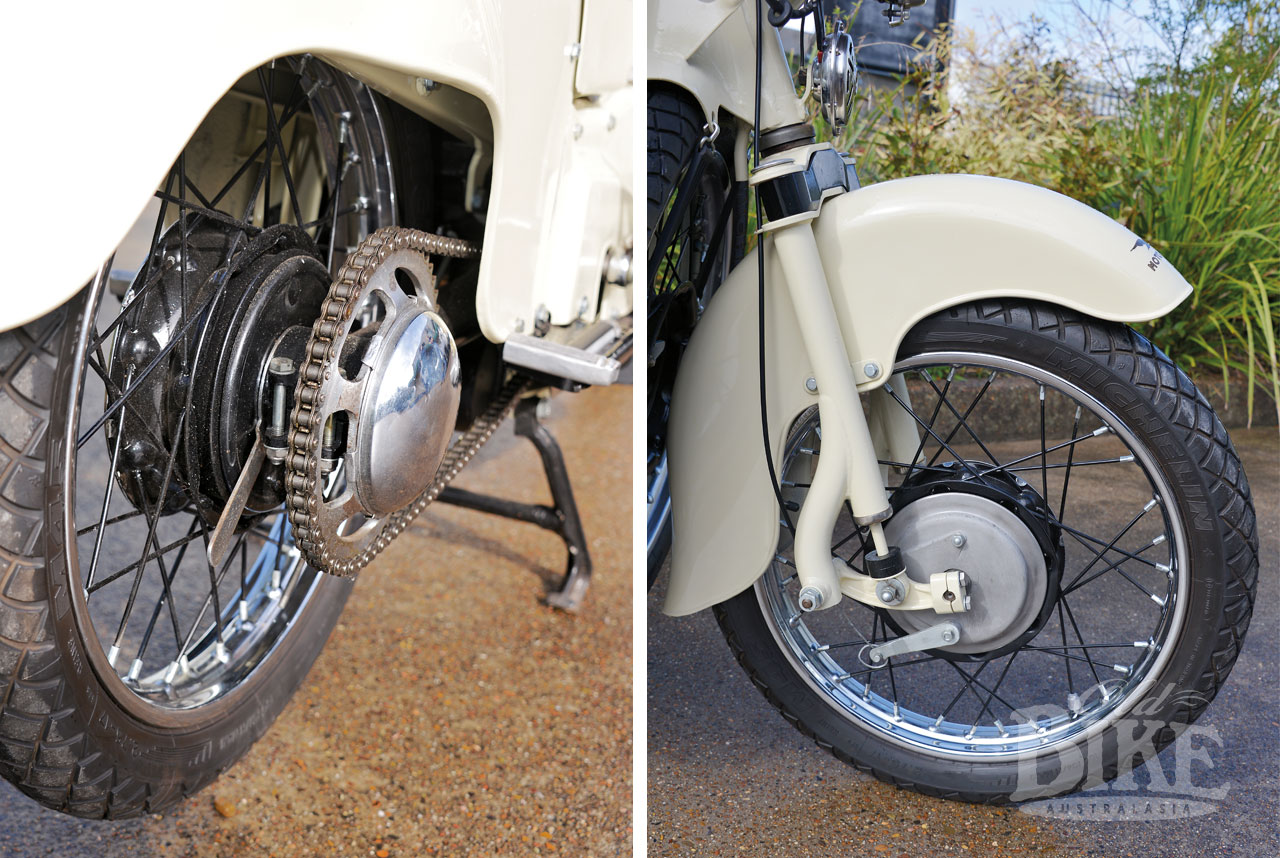
If the Galletto had one impediment to sales, it was the price, which by the end of production had reached 265,000 lire, or about US$380.00. It’s fair to speculate that by the time the Galletto reached the end of its production run, estimated at around 75,000 units over 16 years, it was still more than a match for the new wave of Japanese step throughs, and superior in many ways. But money talks and an OHC Honda for half the price proved to be too tempting for most customers. Some time later, in 1993, Aprilia’s then-owner Ivano Beggio introduced the Scarabeo scooter, a retro-styled machine that became a huge seller and a great influence on competitive brands. In many respects the Scarabeo owed much of its styling, including the use of large wheels and the shape of the bodywork, to the long-gone Galletto; truly a machine ahead of its time.
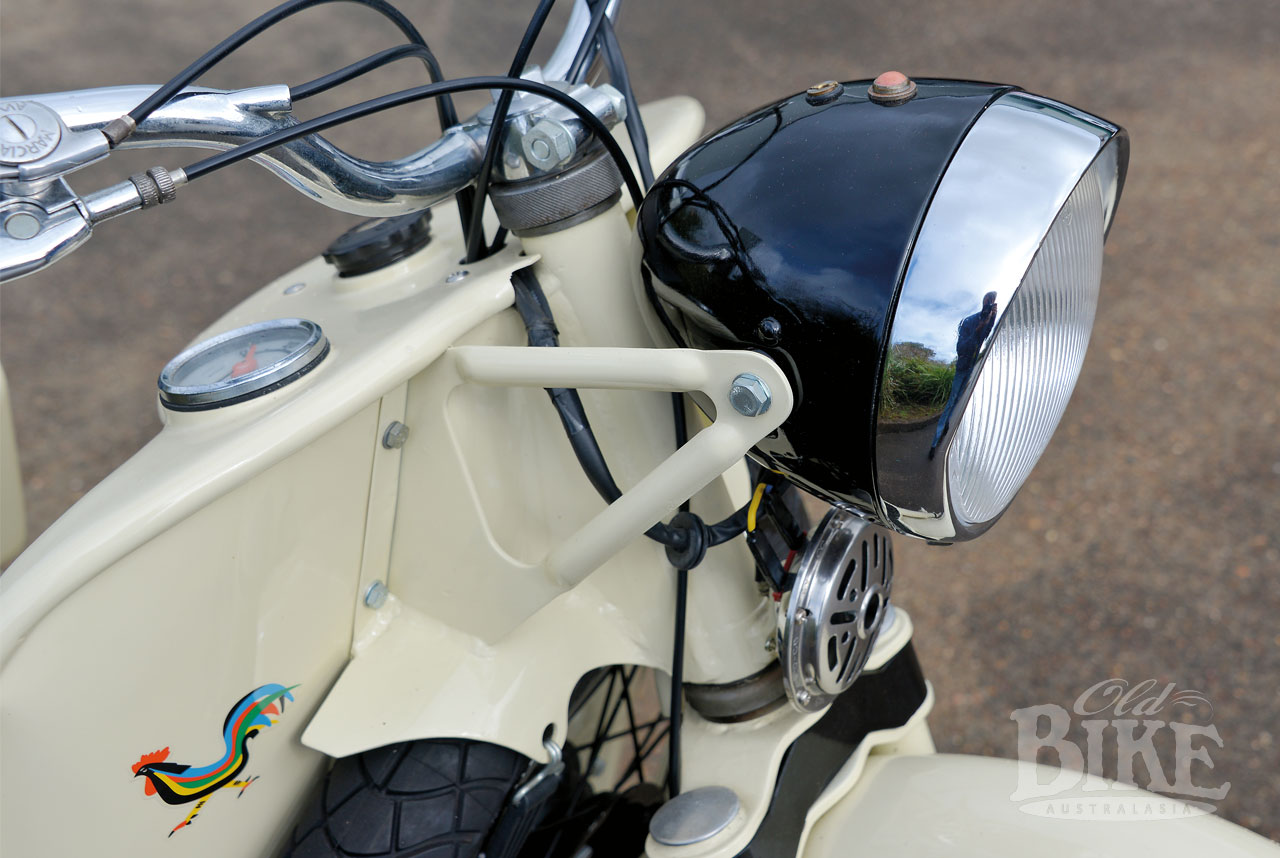
Early testers praised the flexibility of the engine, saying the large external flywheel played a big part in this. One tester even covered a lap of the Isle of Man TT course on the new 192cc model, riding the complete mountain climb and descent in top gear. With plenty of ground clearance, the Galletto could be flung around corners with gay abandon, demonstrating the traditional fine Moto Guzzi handling. Also praised was the machine’s frugality at the pump, sipping just 2.6 litres per 100 km, or 108 mpg.
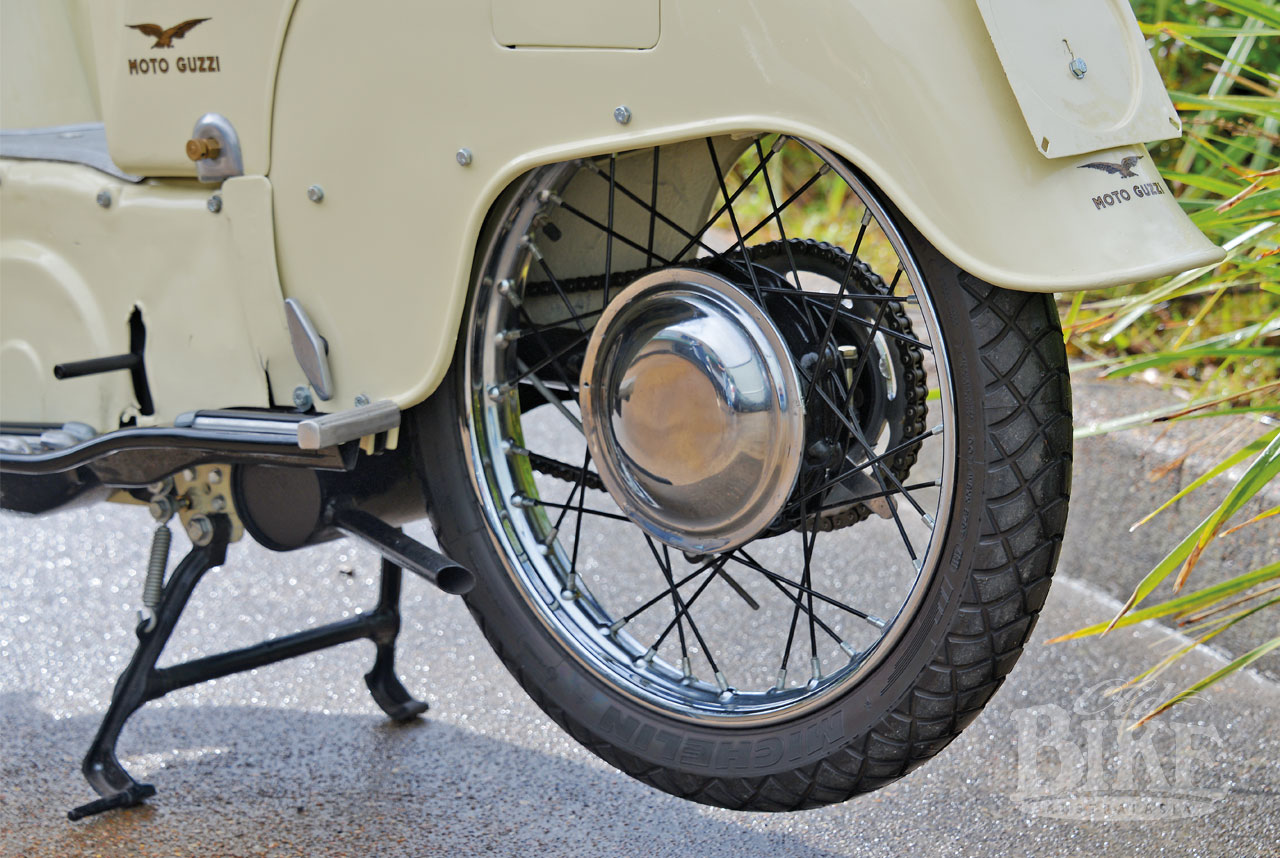
Naturally, the Galletto had its own quirks of design, such as the heel-operated rear brake lever on the left side. A very Italian rocking pedal gear lever sat on the right. Early versions were finished in ivory, later ones grey or, by special order, Guzzi red.
Like its similarly conceived British counterpart, the LE Velocette, the Galletto found favour with the service industry, notably the Italian postal service. In this guise, the Galletto was fitted with substantial panniers beside the rear wheel, and a central top box mounted above the rear mudguard. These versions were finished in white.

Graeme Studdert, owner of Classic Motorcycle Restoration Australia at Gateshead, NSW, is a self-confessed Moto Guzzi tragic (“Even the clothing I wear every day is Moto Guzzi”). He privately imported his 1963 model Galletto, and believes there is only one other example in Australia. Before he took delivery of the machine, a distressing event occurred at the freight terminal in Sydney. “They could not see inside the crate to check the engine number,” says Graeme, “so their solution was to ram the crate with the tines of a fork lift and jiggle them backwards and forwards to create a hole, or two holes. Unfortunately the tines struck the bodywork of the bike and caused extensive damage and there was quite an argument over the repair of the damage. As body panels are virtually impossible to find, I had no option but to do the repairs myself.” He says access to the petrol tank is a major chore that involves removing the rear wheel and the main body structure.
Sitting among other examples from Mandello del Lario, the Galletto looks slightly out of place, yet it is clearly from the same mound. Fresh ideas, beautifully executed – the Moto Guzzi hallmark.
Thanks to Graeme Studdert from Classic Motorcycle Restoration Australia (0400 635 064) for the opportunity to photograph this motorcycle.
Specifications: 1963 Moto Guzzi Galletto
Engine: Single cylinder overhead valve. Dry sump.
Bore x stroke: 65mm x 58mm
Compression ratio: 6.o:1
Carburettor: Dell’Orto 18mm
Ignition and lighting: Marelli dynamo; ignition by battery and coil.
Transmission: 4 speed gearbox in unit with engine. Final drive by ½” x 0.305” chain.
Wheels and tyres: 17 inch on light alloy rims, tyres 2.75 x 17” (front) 3.00 x 17” rear.
Fuel capacity: 9 litres
Dry weight: 265lb.
Top speed: 50 mph (80km/h).


